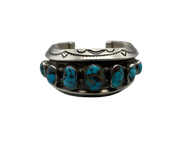People often ask me about the wide range of prices they encounter when searching for turquoise squash blossom necklaces, bracelets, rings, and more. It's a valid question, and I like to simplify it with a comparison: think of it like comparing a Mercedes to a Honda. Both serve the same purpose, but the Mercedes commands a higher price due to factors like quality, reputation, and resale value.
Let's break down why turquoise jewelry prices can vary so much:
The "Mercedes" Pieces
These are the high-end items crafted by renowned artists or unknown artist yet are handmade, quality pieces. The price reflects factors such as:
Artist Reputation: Pieces created by well-known artists or those who have gained recognition in the industry tend to carry a premium.Age and Rarity: Antique (100 years or older) or vintage (made between the 1930s-1970s) pieces, even those without a hallmark, can be highly collectible. Factors like weight, craftsmanship (handmade), and the quality of materials used contribute to their value.Turquoise Quality: Certain types of turquoise, especially rare or high-grade varieties, command higher prices. Natural turquoise, or turquoise from closed mines or those with limited production also adds to the value.The "Honda" Pieces
These are more affordable, sometimes mass-produced items typically lacking the prestige and craftsmanship of high-end pieces. Factors include:
Craftsmanship: Pieces made with prefabricated parts that are soldered on and machine-stamped designs are often priced lower.Turquoise Grade: Common or lower-grade turquoise, as well as dyed or imitation varieties, are common in cheaper pieces.Markings and Weight: Newer Native American pieces are usually stamped with sterling marks and have hallmarks yet vintage and antique items may not have any hallmarks which was common of these type of pieces of that era. Lighter weights often indicate less silver used in crafting, affecting the overall value.When buying turquoise jewelry, it's essential to consider these factors and do your research:
Learn about different types of turquoise, their origins, and rarity.Understand the craftsmanship involved, including handmade versus hand-assembled, and or mass-produced techniques.Check for markings indicating authenticity and quality, such as sterling stamps and artist hallmarks.Seek out reputable sellers who offer transparency, provide detailed information such as weight, size, and a money back guarantee.I've learned through my own collecting experiences that knowledge is key to finding turquoise jewelry that not only captures your heart but also holds its value over time. So, before making a purchase, arm yourself with information and surround yourself with people you can trust. With the right knowledge, you can enjoy turquoise jewelry that not only complements your style but also proves to be a worthwhile investment in the long run.
Bobbi Jeen Olson © 2024
BobbiJeen.com

